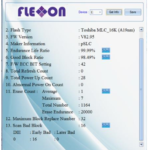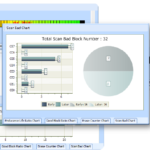 Flash cards are finding their way into many embedded designs. Selecting the right flash technology for a givenapplication is key if cost and reliability goals are to be met. The question remains, how can the lifetime of a flash card be estimated for a given application? Matching the right flash card to the application ensures the system is not over engineered, leading to higher costs, or worst yet, under engineered, leading to failures in the field. Flash cards today are available in 4 different technologies: TLC, MLC, pSLC and SLC. For the purpose of this article we will focus only on MLC, pSLC and SLC. The typical MLC based flash card is rated for 3000 P/E (Program/Erase) cycles, pSLC ranges from 20,000-60,000 and SLC is rated at 100,000. The problem is the relative cost of these solutions. If we use MLC as the baseline, for a given density, a pSLC solution would cost 2 to 2.5X more and SLC would cost 4-5X the price. Certainly, MLC looks like an attractive solution given its cost, but, what about its endurance? What if the card could set an alarm in the system as it approaches the end of its useful life so appropriate action can be taken before it fails?
Flash cards are finding their way into many embedded designs. Selecting the right flash technology for a givenapplication is key if cost and reliability goals are to be met. The question remains, how can the lifetime of a flash card be estimated for a given application? Matching the right flash card to the application ensures the system is not over engineered, leading to higher costs, or worst yet, under engineered, leading to failures in the field. Flash cards today are available in 4 different technologies: TLC, MLC, pSLC and SLC. For the purpose of this article we will focus only on MLC, pSLC and SLC. The typical MLC based flash card is rated for 3000 P/E (Program/Erase) cycles, pSLC ranges from 20,000-60,000 and SLC is rated at 100,000. The problem is the relative cost of these solutions. If we use MLC as the baseline, for a given density, a pSLC solution would cost 2 to 2.5X more and SLC would cost 4-5X the price. Certainly, MLC looks like an attractive solution given its cost, but, what about its endurance? What if the card could set an alarm in the system as it approaches the end of its useful life so appropriate action can be taken before it fails?
Enter the S.M.A.R.T Tool!
S.M.A.R.T Toolprovides the designer with an easy way to monitor the health and remaining life of the microSD/SD card used in the application.
The tool reports the following parameters:
Early Bad Blocks
Later Bad Blocks
Good Block Ratio
Total/Max/Average Erase Count
Remaining Life Ratio
Power Up Count
Total Refresh Count
IC/FW/FW ECC setting, etc.
This information can be used in many ways. For instance, let’s say that you are not sure of how long an MLC card will last in your application. You could run your system with a worst case pattern for a weekend or a couple of weeks (the longer the better…). Then, remove the card from the system and using a standard microSD/SD adapter, plug into a Windows PC/laptop running the S.M.A.R.T Tool.The tool will then read the above mentioned parameters from the S.M.A.R.T enabled flash card and displays the information in an easy to read format.



The key parameters from the card can now be reviewed. The “Endurance Life Ratio” shows the designer what percentage of the “life” of the card remains. Other key parameters can be reviewed as well for signs of premature wear. It is important to note that a flash card does not wear out linearly. In fact, it wears out faster as it approaches the end of its life. Although it is very difficult to determine exactly how long the card will last, this data can still be used to estimate the “best case” life expectancy for the flash card in a particular application. Another factor to keep in mind is density as using a larger density device that is required will also increase lifetime. Armed with this information, the designer is now in a better position to optimize the cost and reliability of the system by selecting the appropriate flash technology (e.g. MLC, pSLC or SLC) and density for the application.
Another key feature is the Alarm function, which generates an alarm in the system when one or more of these conditions occurs:
- Remaining life ratio <10%
- Abnormal power on count > 3,500 cycles
- Maximum bad block replacement <5
The Alarm function gives the system manufacturer (or user) the opportunity to take the appropriate action before a failure occurs.
In summary, flash storage devices offer a reliable and cost effective solution for embedded and computing systems as long as the right device is selected for the application. The S.M.A.R.T tool can help with device selection along with providing flash card health monitoring for systems in the field. Designers looking to optimize cost and long term reliability of their systems should give S.M.A.R.T enabled microSD and SD cards serious consideration.
For more information, visit our website: www.flexxon.com or email [email protected]
Flexxon Memory Card – The best microSD / SD for Industrial / Medical / Automotive Application ( IMA ) with life monitoring tool- S.M.A.R.T






